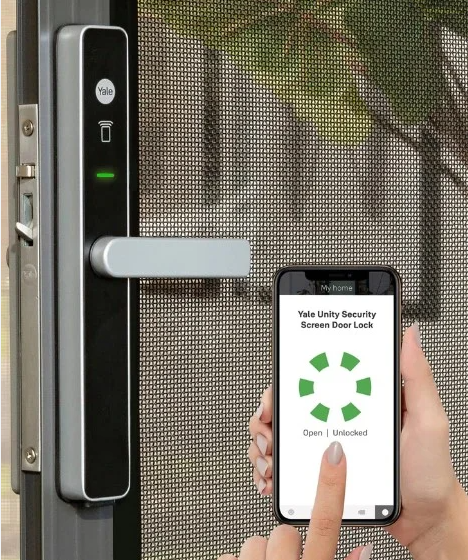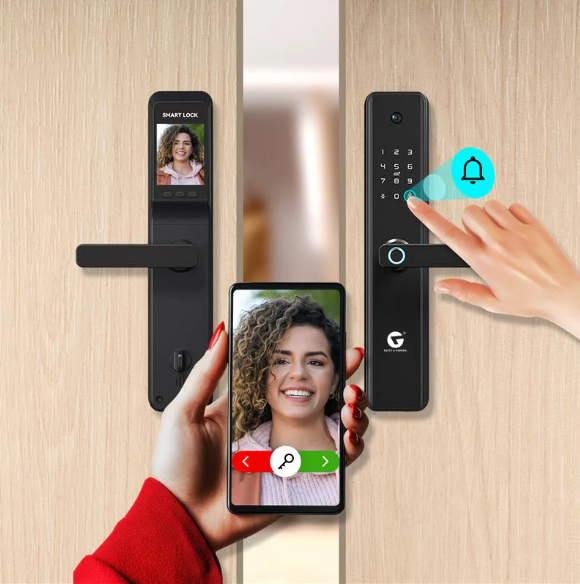With the rise of smart home ecosystems, many homeowners are asking, “Do smart locks work with Google Home?” The ability to control a smart lock using voice commands through Google Home or the Google Home app offers unparalleled convenience and integration. However, integrating smart locks with Google Home raises questions about compatibility, setup, and security. In this comprehensive guide, we’ll explore how smart locks work with Google Home, the benefits and limitations of this integration, and how to ensure smart lock safety through proper smart lock installation, setup, and maintenance. By the end, you’ll know which smart locks are compatible with Google Home and how to set them up securely for a seamless smart home experience.
What Are Smart Locks and How Do They Integrate with Google Home?
Smart locks are advanced locking systems that enable keyless entry through methods like smartphone apps, PIN codes, biometric scans (e.g., fingerprints), or voice commands. They use connectivity technologies such as Wi-Fi, Bluetooth, Z-Wave, or Zigbee to communicate with devices or smart home systems. When integrated with Google Home, a smart lock can be controlled using voice commands via a Google Nest device (e.g., Nest Mini or Nest Hub) or the Google Home app, allowing you to lock your door, check its status, or include it in smart home routines.
The question “Do smart locks work with Google Home?” depends on the lock’s connectivity and compatibility with Google’s ecosystem. Many smart locks are designed to work with Google Home, either directly via Wi-Fi or through a compatible smart home hub. Understanding these integration options is key to optimizing your smart lock setup for both convenience and smart lock safety.

Do Smart Locks Work with Google Home? Compatibility Explained
Not all smart locks are compatible with Google Home, but many popular models support integration, either natively or through a hub. Here’s a breakdown of how smart locks connect with Google Home and what you need for seamless operation:
- Wi-Fi Smart Locks: Some smart locks have built-in Wi-Fi, allowing direct integration with Google Home without additional hardware. You can control these locks using voice commands like “Hey Google, lock the front door” or “Hey Google, is the front door locked?” Examples include certain models from August, Schlage, and Yale.
- Z-Wave or Zigbee Smart Locks: Locks that use Z-Wave or Zigbee require a compatible smart home hub (e.g., Samsung SmartThings or Hubitat) to connect with Google Home. The hub acts as a bridge, enabling Google Home to communicate with the lock.
- Bluetooth-Only Smart Locks: Bluetooth locks typically don’t work with Google Home directly because they lack internet connectivity. However, some models offer a Wi-Fi bridge or hub as an accessory, enabling Google Home integration for remote control.
- Offline Smart Locks: Locks that operate without connectivity (e.g., using only PIN codes or RFID fobs) are not compatible with Google Home, as they lack the ability to communicate with smart home systems.
So, do smart locks work with Google Home? Yes, many do, but compatibility depends on the lock’s connectivity (Wi-Fi or Z-Wave/Zigbee) and whether a hub is required. To find a compatible model, refer to a trusted best smart lock guide that lists Google Home-compatible options.
Benefits of Using Smart Locks with Google Home
Integrating a smart lock with Google Home offers several advantages, enhancing both convenience and smart home functionality:
- Voice Control: Use hands-free voice commands to lock or check the status of your door, ideal when you’re busy or away from the door.
- Smart Home Routines: Include your smart lock in Google Home routines, such as locking the door, turning off lights, and adjusting the thermostat when you say, “Hey Google, good night.”
- Remote Access: For Wi-Fi-enabled locks, you can control your lock remotely via the Google Home app, allowing you to lock or unlock your door from anywhere with an internet connection.
- Activity Monitoring: Some smart locks provide activity logs through the Google Home app, letting you track when your door is locked or unlocked.
- Guest Access: Use Google Home to manage temporary access codes for guests or service providers, streamlining access for vacation rentals or deliveries.
These benefits make Google Home integration a valuable feature for smart lock users, provided the integration is secure and reliable.
Limitations and Security Considerations
While integrating smart locks with Google Home is convenient, there are limitations and security considerations to ensure smart lock safety:
- Limited Unlock Commands: For security reasons, most smart locks don’t allow unlocking via Google Home voice commands without a PIN code or additional verification. You may need to use the lock’s app or a physical key for unlocking, though some models support PIN-based unlocking through Google Home.
- Dependency on Connectivity: Google Home-compatible smart locks typically require Wi-Fi or a hub, which means they rely on a stable internet connection. Internet outages or weak signals can disrupt functionality.
- Hacking Risks: Wi-Fi-enabled locks could be vulnerable to hacking if not properly secured. Using strong passwords, enabling two-factor authentication (2FA), and keeping firmware updated mitigates this risk.
- Smart Lock Battery Life: Wi-Fi-enabled locks may have shorter smart lock battery life (typically 6–12 months) due to constant connectivity. Regular battery checks are essential to prevent lockouts.
By addressing these limitations and following best practices, you can ensure your Google Home-integrated smart lock remains secure and reliable.
How to Set Up a Smart Lock with Google Home
To use your smart lock with Google Home, you’ll need to complete a proper smart lock setup. Here’s a step-by-step guide to get started:
1. Choose a Google Home-Compatible Smart Lock
Select a smart lock that supports Google Home integration, either natively (via Wi-Fi) or through a Z-Wave/Zigbee hub. Check the manufacturer’s specifications or a reliable smart lock guide to confirm compatibility.
2. Perform Smart Lock Installation
Follow the manufacturer’s instructions for smart lock installation. Most smart locks are designed for easy DIY installation, requiring only a screwdriver and 15–30 minutes. Ensure the lock is properly aligned with your door’s strike plate and test it thoroughly. If you’re unsure, hire a professional to avoid installation errors that could affect security or connectivity.
3. Connect Your Smart Lock to Google Home
Here’s how to connect a smart lock to Google Home:
- Wi-Fi Locks: Download the lock’s companion app (e.g., August Home, Schlage Home) and follow the instructions to pair the smart lock with your Wi-Fi network. In the Google Home app, go to “Add,” select “Set up device,” and choose your lock brand to link it.
- Z-Wave/Zigbee Locks: Connect the lock to a compatible hub, then link the hub to Google Home via the Google Home app. Follow the hub’s instructions for pairing the lock.
- Enable the Service: Many smart locks require a Google Home service or action (e.g., “August Home” or “Yale Access”). Search for the service in the Google Home app, link it, and sign in with your lock’s app credentials.
- Test the Integration: Use voice commands like “Hey Google, lock the front door” or “Hey Google, is the front door locked?” to confirm the integration works.
4. Secure Your Smart Lock Setup
To ensure smart lock safety, take these steps during setup:
- Use a strong, unique password for the lock’s app and Google Home account.
- Enable 2FA for both the lock’s app and Google Home to add an extra layer of security.
- Connect your lock to a secure Wi-Fi network with WPA3 encryption.
- Avoid using public Wi-Fi for remote access to prevent interception.
5. Monitor and Maintain Your Smart Lock
Regular smart lock maintenance is essential to keep your lock and Google Home integration running smoothly. Check the smart lock battery life every 3–6 months (most last 6–12 months) and replace batteries promptly when low. Update the lock’s firmware and the Google Home app to patch security vulnerabilities and ensure compatibility.
6. Troubleshoot Connectivity Issues
If your smart lock doesn’t respond to Google Home commands, refer to the manufacturer’s smart lock troubleshooting guide. Common fixes include:
- Restarting the lock, hub, or router.
- Re-pairing the lock with the Google Home app or hub.
- Checking Wi-Fi signal strength or moving the router closer to the lock.
- Ensuring the lock’s firmware and Google Home app are up to date.
Prompt troubleshooting ensures reliable performance and prevents disruptions.

Choosing the Right Smart Lock for Google Home Integration
To ensure seamless integration with Google Home, choose a smart lock with the following features:
- Google Home Compatibility: Confirm the lock works with Google Home natively or via a hub. Check the manufacturer’s website or a home security tips guide for details.
- Strong Encryption: Look for locks with AES-128 or AES-256 encryption to secure data transmitted to Google Home.
- Reliable Battery Life: Choose a model with good smart lock battery life and low-battery alerts to avoid disruptions in Google Home functionality.
- Tamper-Resistant Design: Opt for a lock with a high ANSI/BHMA rating to ensure physical security alongside digital features.
Popular Google Home-compatible smart locks include models from August, Schlage, Yale, and Kwikset, but always verify compatibility before purchasing.
Smart Lock Use Cases with Google Home
Integrating a smart lock with Google Home is beneficial for various scenarios:
- Homeowners: Use Google Home to lock your door with voice commands or create routines that lock the door and adjust other smart devices simultaneously.
- Renters: A portable smart lock with a Wi-Fi bridge can provide Google Home compatibility without permanent installation, ideal for apartments.
- Vacation Rentals: Hosts can use Google Home to manage guest access codes and monitor activity, streamlining short-term rental management.
- Businesses: Commercial-grade smart locks with Google Home integration offer secure access control for offices, with voice-activated locking for convenience.
Common Myths About Smart Locks and Google Home
Several misconceptions about smart locks and Google Home integration can cause confusion. Let’s debunk a few:
- Myth: All smart locks work with Google Home. Only Wi-Fi or Z-Wave/Zigbee locks with Google Home compatibility work, and some require a hub.
- Myth: Google Home integration is unsafe. With strong passwords, 2FA, and secure Wi-Fi, Google Home-integrated locks are highly secure.
- Myth: Smart locks stop working without Wi-Fi. Many locks include Bluetooth, physical keys, or backup power options, ensuring access during internet outages.
By following smart lock tips and choosing a compatible model, you can enjoy a secure and convenient Google Home integration.
Conclusion: Do Smart Locks Work with Google Home?
So, do smart locks work with Google Home? Yes, many smart locks are compatible with Google Home, either directly via Wi-Fi or through a Z-Wave/Zigbee hub, offering voice control, smart home routines, and remote access. By choosing a high-quality, Google Home-compatible smart lock and following best practices for smart lock installation, smart lock setup, and smart lock maintenance, you can ensure a secure and seamless experience. Regular monitoring of smart lock battery life and prompt smart lock troubleshooting will keep your lock and Google Home integration running smoothly.
For help finding the perfect Google Home-compatible smart lock, explore this comprehensive home security tips guide to discover models that balance convenience, security, and compatibility with your smart home ecosystem.